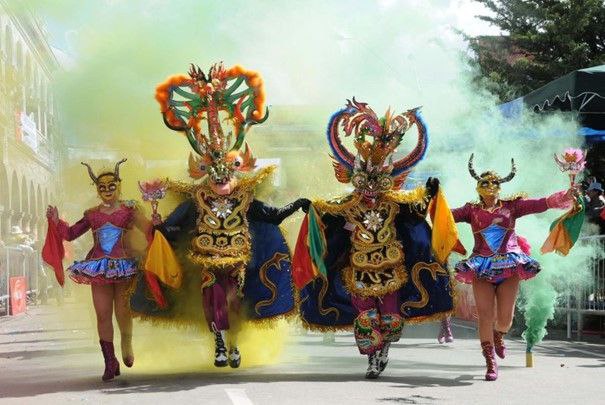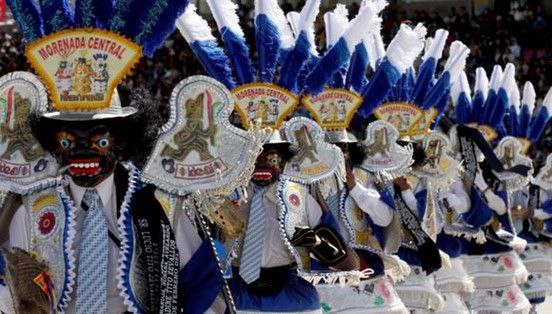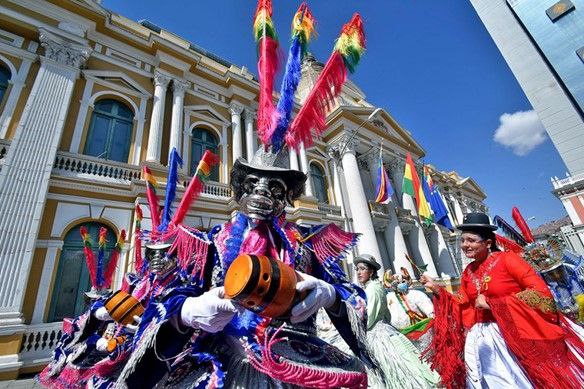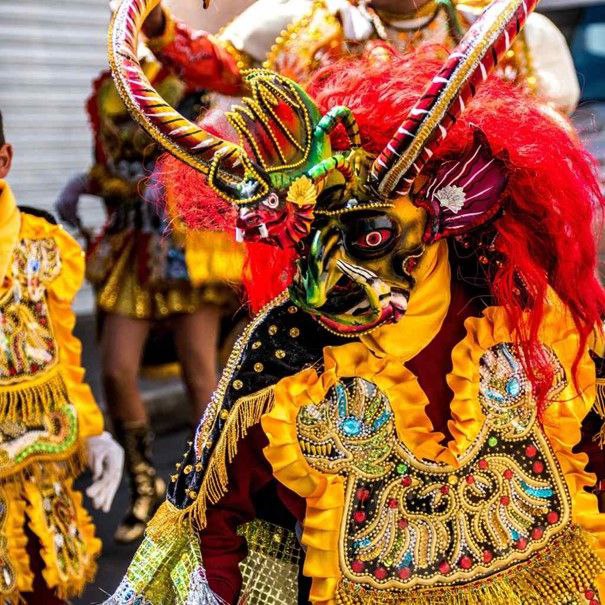Bolivia
List Of Dances
Diablada
(source : Internet)
Bolivia
The Oruro “Diablada” (Devil Dance) dances belong to “masked” most popular of the Bolivian highlands. It is interpreted as the start of the carnival or in processions in honor of a saint “fraternities”, groups that incorporate, in some cases, several hundred participants. Moreover, this dance is understood as “the victory of good over evil.” All the creation myths of Oruro diablada reference samples and there are paintings that allude to the dance from the time of pre-Columbian America.

Morenada

Focusing on both how dancers prepare for performances of la morenada in a local patron saint fiesta as well as a particular dancer’s interpretation of her experiences, it demonstrates how the legitimacy of enacting religion provides a means by which to challenge multiple material and symbolic exclusions from national Argentine society
Bolivia, Peru UNESCO, VIDEO
The origin of la “Morenada” is highly contested between Bolivia and Perú, with both having celebrations recognized by the UNESCO as Intangible Cultural Heritage In both countries.
A theory commonly shared says that the dance was inspired by the sufferings of the African slaves brought to Bolivia in order to work in the Silver Mines of Potosí.

(carnaval de Ouro)
credit : Trans Americas Journey
Voir : https://myvirtualworldtrip.com/2021/07/22/traditional-dances-of-bolivia/
Lire Aussi
Bailar con fe: Folkloric Devotional Practice in a Bolivian Immigrant Community
This article explores “folkloric devotional practice,” the intersection of religion and folklore, in Bolivian immigrant dance practice in Buenos Aires, Argentina.
Ch’utillos Festival

REFERENCE : Unesco
Read the full article
See the Video Unesco’s website
Bolivia
Region : different
Spirituality : Tradition
Ethnic group : San Bartolomé and San Ignacio
Ch’utillos, or the Festival of San Bartolomé and San Ignacio de Loyola, is celebrated in Potosí, Bolivia in the month of August. An integral part of the local cultural identity, the festival is characterised by gastronomic fairs, dance performances and a procession to the sanctuary located in the Mullu Punku gorge, a natural site with rock formations. In the city, parishioners and musical groups take part in the Autochthonous and Folkloric Dancing Parade of Ch’utillos and are joined by rural communities wearing traditional clothing. Some travel up to 200 kilometres to reach Potosí, from towns bordering Argentina, contributing their traditions and oral expressions to the dancing parade. Dance groups from other Latin American countries also join the festivities, transforming the streets of Potosí into a platform for cultural exchange. Other bearers include the people who make the traditional musical instruments, clothing, accessories, and dishes. The knowledge and skills of Ch’utillos are transmitted informally, through oral instruction and participation in the festivities. A symbol of faith and tradition, the Ch’utillos festival is part of the cultural heritage of the indigenous Q’ara Q’aras nation, marking the beginning of the preparation of the land and a new agricultural cycle, with offerings to Pachamama (Mother Earth).

